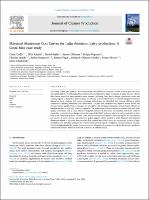| dc.contributor.author | Duffy, Colm | |
| dc.contributor.author | Apdini, Titis | |
| dc.contributor.author | Styles, David | |
| dc.contributor.author | Gibbons, James | |
| dc.contributor.author | Peguero, Felipe | |
| dc.contributor.author | Arndt, Claudia | |
| dc.contributor.author | Mazzetto, Andre | |
| dc.contributor.author | Vega, Andres | |
| dc.contributor.author | Chavarro-Lobo, Johan A. | |
| dc.contributor.author | y 2 autores más. | |
| dc.date.accessioned | 2021-06-10T03:10:19Z | |
| dc.date.available | 2021-06-10T03:10:19Z | |
| dc.date.issued | 2021-05 | |
| dc.identifier.uri | https://doi.org/10.1016/j.jclepro.2021.127556 | |
| dc.identifier.uri | https://repositorio.catie.ac.cr/handle/11554/10913 | |
| dc.description.abstract | This study utilises data collected from Costa Rican dairy farmers to conduct a cradle to farm gate Life Cycle Assessment and the first Marginal Abatement Cost Curve (MACC) for dairy production in Latin America. Ninety dairy farms across five farm typologies were assessed, reflecting Costa Rica’s diverse agroclimatic zones and varying degrees of dairy/beef specialisation. The efficacy and cost-effectiveness of specific mitigation measures depend on farm typology, but several promising technologies are identified that increase efficiency whilst substantially reducing emissions across most farms – in particular, measures that improve animal health and increase pasture quality. Pasture measures are synergistic with silvopastoral practises and are highly effective at emission mitigation, although relatively expensive. The replacement of lower quality by-product feeds with high quality concentrate feed is a cost-effective mitigation measure at farm level, but emission reductions could be negated by indirect land use change outside the scope of the MACC analyses. Achieving carbon neutrality at farm level is not likely to be possible for most farms, with the exception of extensive farm typologies. Not all measures are suitable in every context, and additional policy support will be needed to offset financial and technical challenges related to adoption. Results of this first tropical dairy MACC study are constrained by lack of highresolution data, but they highlight the need for farm-typology-specific mitigation recommendations. Overall, there is a high potential for pasture improvement and silvopastoral measures to mitigate the globally significant contribution of Latin American livestock production to climate change. | es_ES |
| dc.language.iso | en | es_ES |
| dc.publisher | Elsevier, Ámsterdam (Países Bajos) | es_ES |
| dc.relation.ispartof | Journal of Cleaner Production Volumen 311 (2021) | es_ES |
| dc.rights | info:eu-repo/semantics/restrictedAccess | es_ES |
| dc.subject | MITIGACIÓN DEL CAMBIO CLIMÁTICO | es_ES |
| dc.subject | PRODUCCION LECHERA | es_ES |
| dc.subject | AGROCLIMATOLOGIA | es_ES |
| dc.subject | MITIGACIÓN | es_ES |
| dc.subject | PASTOREO | es_ES |
| dc.subject | SISTEMAS SILVOPASTORILES | es_ES |
| dc.subject | GANADERIA | es_ES |
| dc.subject | EMISION DE GASES | es_ES |
| dc.subject | CAMBIO CLIMÁTICO | es_ES |
| dc.subject | AMERICA LATINA | es_ES |
| dc.subject | COSTA RICA | es_ES |
| dc.title | Marginal Abatement Cost Curves for Latin American dairy production: A Costa Rica case study | es_ES |
| dc.type | Artículo | es_ES |


